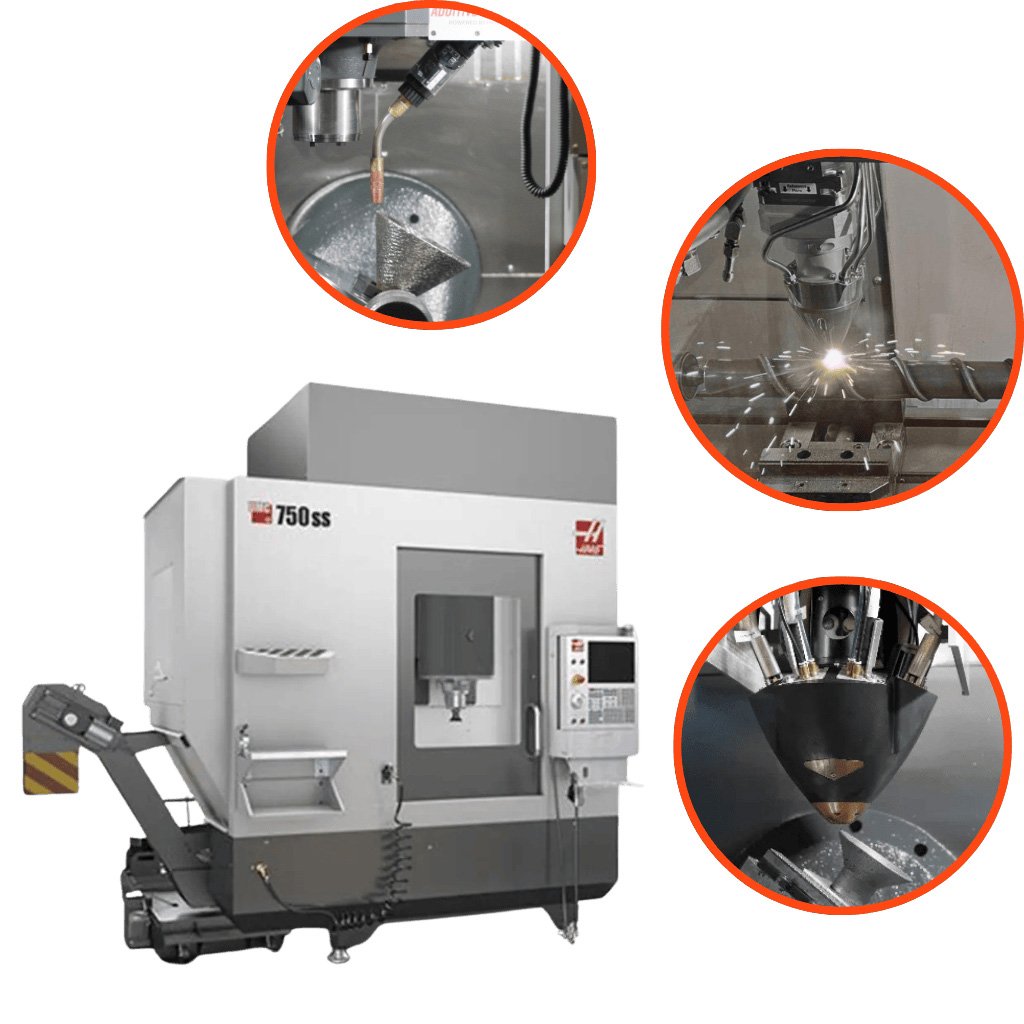Phillips Corporation hybrid manufacturing machines integrate additive manufacturing technologies with Haas CNC platforms. This integration of processes is an example of where manufacturing is heading.
As the manufacturing industry advances, hybrid machines will play a larger role in manufacturing operations. These machines have been proven to save manufacturers time, lead to cost savings, and improve operational efficiency. Utilizing hybrid options gives manufacturers a clear advantage over their competitors.
With these benefits, hybrid machines are an asset to manufacturing companies. Over the next few years, the hybrid market seems poised to grow even more, underscoring the idea that hybrid technologies will be prominent in the future of the manufacturing sector.
 Capabilities and Applications of Hybrid Manufacturing Machines
Capabilities and Applications of Hybrid Manufacturing Machines
Additive hybrid systems combine the capabilities of additive manufacturing and CNC machining in a one-stop-shop machine. The ability to integrate a 3D printer into CNC machines allows machine shops, educational institutions, and training programs to break into the additive manufacturing space with a relatively low entry cost.
Alex Potts, sales manager of the Hybrid Division at Phillips Corporation, explains the capabilities of their hybrid system: “The machines take a print head that uses either laser wire DED, laser powder DED, or wire arc welding technology. We mount the head directly next to the CNC machine’s spindle casting. That allows machinists to switch back and forth between printing and machining metal.”
These machines are exclusively for metal 3D printing, with the ability to work with various steels, Inconel, copper, aluminum, and alloys. Currently, hybrid machines have a few main use cases, including education purposes, cladding and repair applications, casting replacements, and material validation.
“One great application with hybrid machines is they give manufacturers the ability to iterate,” says Phillips’ Hybrid Applications Manager Randy Behm. “Manufacturers can use these machines to print new parts and then machine them within the same set-up. This allows them design flexibility, so they can experiment with different geometries. They’re able to complete rapid iterations of different prototypes to improve the end product.”
Hybrid machines are also an excellent choice for low production runs. These low batch runs are often for parts that are made of uncommon materials or are non-standard sizes. Due to the low volume, it would be prohibitively expensive to manufacture these parts traditionally.
“With the hybrid systems, you can bring that low volume production in house,” says Potts. “Since they don’t have to outsource the job, that capability saves manufacturers lead time and cost.”
Industry Adoption of Hybrid Manufacturing Machines
For hybrid machines to have a place in the future of manufacturing, there needs to be greater adoption of these systems. Both Potts and Behm agree that this increase will happen naturally once more manufacturers have a greater understanding of the advantages of hybrid manufacturing.
Expediting production timelines is one of the main benefits of adopting hybrid machines. Behm explains, “Using traditional manufacturing methods, product design timelines can take more than six months. With a hybrid machine, manufacturers can reproduce that part in less than two weeks and then move on to the next iteration of that design. That gives you an edge over competitors and brings your overall engineering timeline down.”
Once manufacturers have this capability in-house, they realize how invaluable it is. Hybrid machines offer flexibility, especially in unexpected situations. In these scenarios, manufacturers don’t have to rely on an external supplier to solve their problem. Instead, they can turn to a hybrid machine to print and machine what they need.
“There are parts you can manufacture with a hybrid system that can’t be made with a traditional CNC machine. That’s a compelling feature of the hybrid machines, having the ability to create things that otherwise can’t be created,” says Potts.
Adopting hybrid machines gives manufacturers the potential to have more design freedom and supply chain resiliency. Another consideration is cost. Hybrid manufacturing can help manufacturers with cost savings. They can use less material to create the same part, and even use different materials throughout one build.
“Being able to switch to a different material in the middle of the build gives manufacturers flexibility to use more affordable materials,” Behm explains. “With traditional manufacturing methods, creating that same build would be a lot more expensive and time consuming.”
Aside from just cost savings, hybrid systems are also a lower entry cost into additive manufacturing for most manufacturers. Phillips’ Hybrid team is often adding additive capabilities to existing machines, which makes it more affordable for manufacturers to adopt 3D printing. The cost of turning a CNC machine into a hybrid machine is about a quarter of the cost of a full turnkey additive solution.
Heading Into the Future with Hybrid Manufacturing
Present-day hybrid machines have some significant advantages over traditional manufacturing operations. And hybrid capabilities are only going to get better as manufacturing technology continues to advance.
“15 to 20 years down the road, every machine shop in America should have hybrid capability in some capacity,” Potts says. “We can’t stress enough the time and cost savings, and the major benefits of having a machine like this in-house.”
Behm sees hybrid technology becoming even more economical for manufacturers in the future. “Raw materials are cheaper now, but as manufacturers adopt additive technologies, materials like powdered metal and welding wire could become the more affordable option.”
Hybrid systems won’t just affect how parts are manufactured in the future, though. It’s going to have a significant impact on the future industrial workforce. There’s currently a lack of interest in the manufacturing field among younger generations, but there is a growing attraction to 3D printing.
“Manufacturers need to be investing in additive manufacturing. Anyone who doesn’t see its role in the industry’s future is going to get left behind,” says Potts. “Not only can this be a tool to attract a younger workforce, it’s also a skill current machine operators need to have. Upskilling with additive enables manufacturers to grow their workforce’s skillset.”
Additive doesn’t only make companies more attractive to the workforce, it also generates attention from original equipment manufacturers (OEMs). The condensed production timelines enabled by hybrid machines are a more attractive option when OEMs are considering suppliers.
“If you’re a front runner in the hybrid space, you’ve got an advantage over other companies. And that is what will drive more adoption of hybrid machines,” says Behm. “As manufacturers see others being successful with this technology and see commercial applications develop, that’s when hybrid machines will become prevalent in the industry. People want to see someone else succeed first before they go all in.”
Overcoming Obstacles to Hybrid Adoption
Hybrid machines have clear benefits for manufacturers, and this will lead to the technology being widely adopted in the future. But what’s keeping manufacturers from readily embracing the technology today?
“One hurdle to overcome is getting people to trust in additively manufactured parts,” says Behm. “With the rise of Industry 4.0 and its focus on data, it is becoming easier to gather performance data on these parts.”
More testing of 3D printed parts will help the manufacturing industry have confidence in this technology. A lot of hybrid machine testing is currently being done by universities that are well suited to do in-depth research on a wide range of materials.
“As processes get validated and there’s more information on how to qualify parts, I think that will be a turning point for hybrid,” observes Behm. “Manufacturers have to make sure material properties are the same before putting an investment into these machines.”
Potts says that the testing results they’ve seen from their hybrid machines have been impressive. He expands, “The parts that we print have the same material properties as conventionally manufactured material. Almost every customer that we’ve done benchmark parts for testing has ended up going the hybrid route because they trusted the data they collected and see it as a viable option for manufacturing.”
Another obstacle to adopting hybrid is the technical limitations when dealing with software. To effectively utilize a hybrid system, manufacturers must have workers who can program these machines. It’s not as simple as using a regular 3D printer and it involves some tool path planning and other considerations where having a machining background helps.
With hybrid being a more unique technology, only a few software companies support programming of these machines. As the technology becomes more mature and more people adopt it, this number will grow, but presently that software component is a barrier to hybrid adoption.
“The challenge is how do you get programmers who are experienced enough and how do you educate them to learn this additive side,” Potts explains. “Because programming really is the hardest part of these machines. That’s why companies like Phillips provide on-site training with hybrid systems. But much like the jump from 3-axis to 5-axis CNC programming, additive programming introduces new concepts that take more time and practice to develop competency.”
An Integrated Future
The future is not only hybrid, but also integrated. Whether manufacturers are integrating CNC machining and 3D printing or other processes. This integration strategy helps further advanced manufacturing goals of having more automated facilities and eventually achieving lights-out manufacturing.
“With hybrid machines, manufacturers can reliably 3D print and machine lights-out and utilize advanced software to have process control. As the software progresses, these machines will be able to auto-correct processes and optimize production to create higher quality parts,” says Potts.
There is a growing interest in hybrid manufacturing and as more manufacturers adopt these machines there will be numerous use cases on the benefits and advantages of hybrid.
“The flexibility of having essentially a whole factory in one cell is invaluable. And hybrid is just one piece of that. It’s a great example of where the future of manufacturing is headed,” says Behm.
If you’re a manufacturer interested in how a hybrid machine can benefit your company, reach out to the Phillips Hybrid Team to learn more. In addition to their machines, they also offer support and resources to their partners to help manufacturers feel confident that hybrid is a viable business case. And if you want to explore even more advanced manufacturing technologies and see how they can benefit your operations, learn more about the Smart Manufacturing Experience.
Biographies
Alex Potts
 Alex Potts is the Sales Manager for the Hybrid Division at Phillips Corporation. He has a background in materials science and engineering and is dedicated to advancing additive and hybrid manufacturing initiatives around the world.
Alex Potts is the Sales Manager for the Hybrid Division at Phillips Corporation. He has a background in materials science and engineering and is dedicated to advancing additive and hybrid manufacturing initiatives around the world.
Randy Behm
 Randy Behm is the Applications Manager for the Hybrid Division at Phillips Corporation. With a background in Machining and Fabrication, he is committed to training new operators on the use of Hybrid equipment and the development of new products and processes for Hybrid Manufacturing.
Randy Behm is the Applications Manager for the Hybrid Division at Phillips Corporation. With a background in Machining and Fabrication, he is committed to training new operators on the use of Hybrid equipment and the development of new products and processes for Hybrid Manufacturing.
